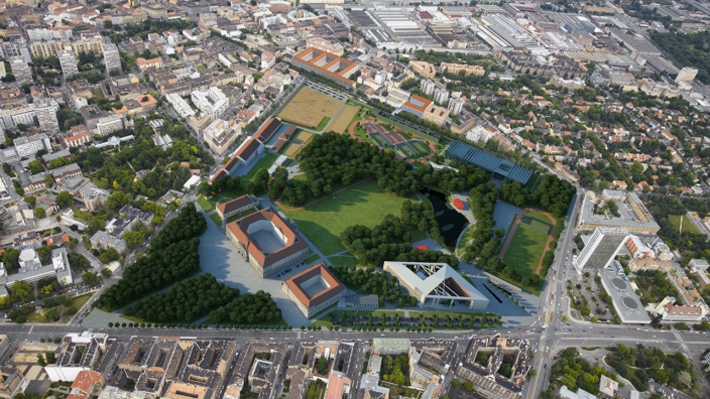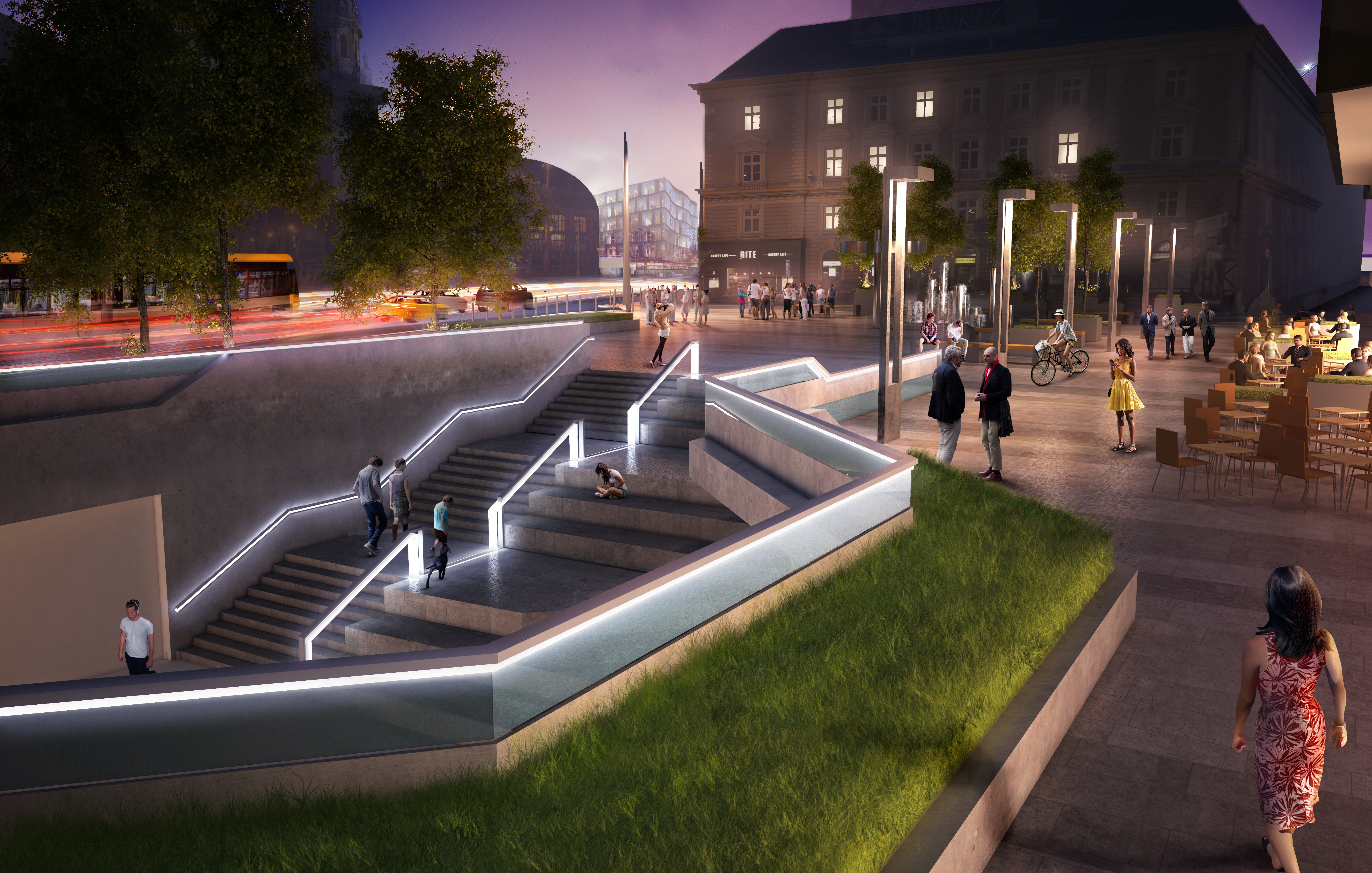There are many promising developments expected to be started or completed in Budapest this year. Here we present some details as well as artist impressions, so you get a glimpse at what's likely to change. Our compilation includes public spaces, parks, museums, university buildings and new sports facilities.
'We'd like to create a simpler, more robust, not over-structured space,' says the chief architect of the District, István Matus. Looking at the visualisations, it is clear that by the elimination of the now unnecessary stairs, a more transparent and orderly urban space will be created opposite the Nyugati Railway Station, without losing one of its core functions as a prime meeting point. The space will become greener - as much as possible - although the reinforced concrete structures underground don't allow for larger tress. Nonetheless the situation will be a definite improvement on the present. The renovation of the Square is made possible by TÉR-KÖZ, a large scale call for tenders announced by Mayor's Office.
Improvements to Terézváros do not stop here. Several ten thousands square metres of public park will be created on the territory of the so-called Nyugati Grund (Western Grounds). The temporary utilisation of this largely fallow area currently in the use of the State Railways will create new green surfaces, sports grounds and recreational zones. This huge space will still be well within the folds of the city as it's in the immediate vicinity of the Grand Boulevard and the Nyugati Railway Station. Terézváros will also continue its popular portal renovation program, which will be hopefully be joined by other Districts as well.
It is again the TÉR-KÖZ program that makes the renewal of Szervita Square possible. Numerous plans have been created for the renovation of this small but beautiful downtown square; a few years ago, even the celebrity architect of Iranian origin, Zaha Hadid, designed visuals for this spot. His bubble-shaped building, it seems, won't be realised, but the renovation of the 18th century St. Anne's parish church was completed recently and we'll be able to admire other treasures, as well, in the soon-to-be reborn square, such as the Rózsavölgyi House designed by Béla Lajta.
The much awaited renewal of Széll Kálmán Square has been a recurring topic, but now it seems that construction works will begin this year to transform one of the busiest traffic junctions of Buda. We'd like to spare you the details of the delay and instead talk about what is expected to happen. The size of the bus parking area will decrease, the green surface ratio will grow, the underground metro's building will be reconstructed, escalators and elevators will be added to facilitate access to Várfok Street, bike paths will be created for easier crossing, vendors' booths will disappear, and the preparations for the new terminal of the cogwheel railway will begin. The designs are by Főmterv Mérnöki Tervező, Építész Stúdió and Lépték-Terv.
Many, including Budapest's chief architect, Sándor Finta,consider the renovation of the Nehru Bank to be one of the most promising possibilities of Ferencváros - and the entire capital. As a result of the project, the green surface of the park will be refreshed, and a floating garden, a BMX park and an outdoor gym will be added. The plans also include sun-beds, chess tables, a sledge slope, a dog run and a running track. Although we have no major news, we hope this investment will also be realised this year.
As part of the oft talked about revitalisation of the Danube banks areas that have so far been neglected might come to play an important role now. The renovation of the Hullám Boathouses on the Pesterzsébet banks, which is already under way, are also courtesy of the TÉR-KÖZ tenders. The foundation stone has been laid down, so the protected buildings of architectural value and the docks will soon be renewed in line with the designs of Blokk Architects. Plans also include the addition of sunbathing piers, a buffet terrace, a water-themed playground, a community garden, and a pedestrian-bicycle bridge that connects Gubacs with the Danube banks over Helsinki Road. All this means that everything is given for the emergence of a popular riverbank site from a long-neglected area.
One of the largest developments of Józsefváros is a project called Ludovika Campus, that would give this quarter back its 'historical university town character.' In addition to the reconstruction of the main building that was designed by the famous Hungarian architect Mihály Pollack and originally opened in 1836, the project includes the renovation and construction of numerous other buildings. The renewing Orczy Garden will remain open to the public, complemented by public sport grounds (free to use outside school hours), a multifunctional sports facility and a swimming pool. With at least 50, no longer used, buildings demolished, the green surface area will increase despite of the planned constructions. The boating lake, the riding hall and the stables will also be reborn. The latter will be partly open so kids and horse fans can meet the four-legged creatures in person. The establishment of a dormitory for 600 law enforcements students in Diószeghy Street also seems to be a good idea, since it means the renewal of an abandoned area, an improvement in public safety, and the revival of the whole District.
Also in Ferencváros, not far from Ludovika, in the area of Vaskapu Street and Tóth Kálmán Street, where the Academy of Sciences Research Centre for Humanities is already under construction. The researchers are currently working in buildings that are inefficient to operate because they are strewn around town. Under the improvements they will be moved into three new blocks. This project is the twin of the Research Centre for Natural Sciences in Lágymányos, which was completed in autumn 2013. The development is expected to enhance cooperation between various fields in the area of humanities studies, as the research groups housed in the new centre include experts in music, archaeology, literature, ethnography, art history, history, philosophy, political science, law sociology, minority studies and economy. The buildings designed by M-Teampannon include section halls, as well as various archives and a huge library.
As we reported last December, the development of the Central European University campus near St. Stephen's Basilica will soon be under way, so the buildings currently scattered around town will be concentrated around the Nádor Street main building in the future. The designs by the noted Irish studio O'Donnell&Tuomey and the architects behind the new MTA research centre M-Teampannon are quite promising. Of course large-scale construction works in close proximity to protected city buildings does raise a few questions among experts and locals. By 2019 the new educational and research facilities, the reconstruction of the old auditorium, the transformation of the library that has the largest English-language collection in Central Europe, and the addition of a café suitable for studying, plus a rooftop garden serving as a community space are expected to be complete.
The construction of the swimming pool near the Tüskecsarnok that we introduced when it was completed after a 20 year wait, is at full steam. The result is expected the be a state-of-the-art sports complex, home to at least 20 disciplines. The facility will provide professional facilities with a 50-metre pool and a 1000-seat stand, a learning pool of variable depth and a wellness area. The facility will be open to nearby university students and the public, as well as professional sportspeople of course!
Preparations for the Liget Budapest project aimed at the renewal of City Park is also under way. Europe's largest museum-precinct development has attracted plenty of attention. Altogether 470 tenders were received and these were judged by an 11-piece international committee and 36 experts on the basis of a list of 5 concerns.
The environmentally conscious design of the House of Hungarian Music by the Japanese Sou Fujimoto Architects has even caught the attention of the noted archdaily.com. The Középülettervező Zrt. (more precisely Zoltán Tima's studio) responsible for the Liszt Ferenc Airport's Skycourt and last year's successful renovation of Kossuth Square will design the new building that houses the Museum of Photography Budapest and the Hungarian Museum of Architecture. The Museum of Ethnography will be constructed in harmony with designs of the French Vallett de Martinis DIID Architects. An invitational for tender was announced for the building of the New National Gallery-Ludwig Museum, and entries by the likes of Jean Nouvel and David Chipperfield are expected. A call for tenders for the comprehensive reconstruction of the park will be announced this year.
The reconstruction of Ödön Lechner's now run-down Museum of Applied Arts can finally begin. The reconstruction project by the Vikár és Lukács Architect Studio focuses primarily on preserving the historical monument's values, while a contemporary, crystal-shaped building will also be added to the main building to facilitate the efficient, 21st Century operation of the museum. After the Rembrandt exhibition, the Museum of Fine Arts will also close in March to give way to large-scale restoration works. The institution will reopen after the facelift, and visitors will then be able to enjoy the magnificent Romanian Hall, which has been used as a storage space since WWII.
Plenty of our historical buildings will be reborn: the so-called Royal tenement palace was built for the ruler and his company at the turn of the 19th Century. The reconstruction of the Ferenciek Square face of a gigantic, 6-storey building designed by Flóris Korb and Kálmán Giergl is now completed, so the contrast from the direction of Jégbüfé has become all the more noticeable. A completely new building will soon emerge from beyond the blackened facades.
In addition to these, Budapest will see numerous transport developments as well. Tram number 1 will connect to Fehérvári Road (soon to undergo reconstruction as well) over the Rákóczi Bridge within weeks. The reconstruction of tram line number 3 will be finished this year too, and the interconnection of Buda's tram lines is also in the making. There are plans for the reconstruction of a part of Üllői Road, the construction of the Sasad overpass, and several P+R car parks. The gradual introduction of e-tickets could also positively influence Budapest's transportation system.
In this article, we tried to summarise all the major urban development projects expected in Budapest in the near future, but we are well aware that the list is incomplete, since numerous other buildings, squares and parks will also receive renewal this year. We promise to try to keep you updated with the developments while you continue to enjoy this city, which grows more beautiful by the hour.





